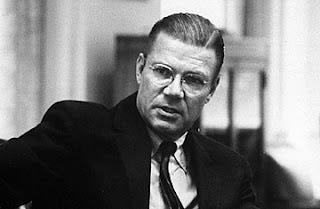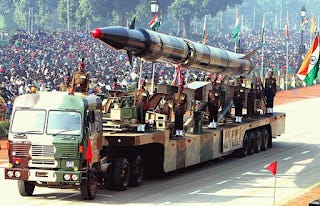The Department Offense
Between 1961 and 1968 the US Department of Defense was run by a man whose achievements before and after joining the US government include stints as President of the Ford Motor Company and President of the World Bank.
Under Kennedy and Johnson, Robert MacNamara (by all accounts a nice guy) oversaw the industrial slaughter of hundreds of thousands of unarmed men women and children, the complete ruination of an otherwise developed country and a legacy of chemical attack that is still playing havoc with the health of children born 40 years after US forces left Vietnam.
This, without mentioning the absurd level of bombing of nearby Laos where it is estimated that after the war as many as 288 million cluster munitions and 75 million unexploded bombs were left across the land. Like kernels of super-heated corn, ordnance is still going off throughout Laos - causing death and horrific injuries, even today. At least there were no nuclear weapons involved, right? Can´t have been that bad. Well, lets see.
The false barometer
One of the tragedies of the dropping of two nuclear bombs over Japan in 1945, is that even today these bombings are spoken of in almost hushed terms - as if Fat Man and Little Boy epitomize the apex of destruction that our military forces are capable of. What captures the imagination with Hiroshima and Nagasaki is the swiftness of the destruction; the massive death toll offered up by just two devices - each not much bigger than the average refrigerator at the time.
Unfortunately, the barometer of atrocity is stuck in 1945, reinforced by grainy images of mushroom clouds towering into the sky over Japan. Although powerful and massively destructive, Fat Man and Little Boy pale in comparison to destructive power of just one ordinary item in the nuclear arsenal available to any despot that seizes the reigns in no less that 9 countries today —
United States
Russia
United Kingdom
France
China
India
Pakistan
Israel
North Korea
Any one of these countries can unleash on the world destruction hitherto known in under an hour. And the likelihood of nuclear war is entirely dependent on the configuration of international leaders at any one moment.
Think of a game of poker: dealt the right hand planet earth could be very easily at the center of an international firestorm - with cities around the globe going up in smoke. The best estimate of total number of nuclear warheads possessed by this happy lot? 16,300
Some people think that Pakistan and India will probably bomb each other in the not too distant future. If so, it will be up the remaining countries to remain calm as these two nations blow large sections of their populations to Jannah and into endless cycles of birth and rebirth.
Lest We Fallout
The other aspect is the nature of the bombs - the dreaded word nuclear, but actually a nuclear attack does necessarily mean long term radiation pollution. Often the radiation is a by-product, not the payload. The payload is unholy, pressure, hire, fire, wind and vacuums.
During the bombings of Hiroshima and Nagasaki, the ´best´ place to be when the bombs went off was right at the hypocenter, as you would have died immediately. The worst place to be - was on the outer edges of the cities. In Hiroshima, 66,000 people were killed as a direct result of the blast, 69,000 injured (picture people were their skin burnt off their bodies.) In Nagasaki least 35,000–40,000 people were killed and 60,000 others injured.
The bombs dropped on Hiroshima and Nagasaki never actually landed on the ground - hence where there are no craters. Both bombs detonated approximately 1km up in the skies above their respective targets, meaning that the radiation emitted by the fission material required to create the blast was dispersed over a massive area by wind. Nagasaki and Hiroshima were chosen not because they were directly militarily important (they were not) but because they were largely wooden cities and so easy to burn.
Neither Little Boy or Fat MAan left any significant long term radiation pollution in Japan. 50 years on - and Hiroshima and Nagasaki are both thriving cities with populations of - 446,000 and 1,154,391 respectively.
A Ton Of Bricks Or A Ton Of Feathers?
The total firepower unleashed on Vietnam by US forces has been calculated at 640 times the equivalent of each of the bombs dropped on Hiroshima and Nagasaki. So no nuclear bombs - but with that kind of destruction, does it really matter?
The only difference is the time scale. The death toll was not even equivalent. It was a lot higher. And even if we factor in radiation as one of the scarier aspects of nuclear bombs, it doesn´t take just radiation to poison the land.
Additionally to bombing and burning massive tracts of land with napalm, the US forces doused huge tracts of land in Agent Orange - essentially a highly toxic weedkiller. The long term effects on the population are not dissimilar to those we might expect from long term exposure to radiation - cancer, birth defects and so on. And they are still being felt today.
In any case, even if Fat Man and Little Boy were the most potent bombs manufactured by mankind to date (they are not and not by a magnitude too), to measure the ferocity of an attack by using the simple calculation of body count divided by time shows extremely poor ethical judgement.
Would it matter, say, if Harold Shipman - the psychopath doctor in the UK had killed all his victims in one day? Would his sentence (if it were possible to increase it) have been any higher if he had someone managed to kill 250 victims in a week as opposed to over 23 years?
"Your Honour, the defense would like to to submit to the jury that while Mr Shipman is profoundly regretful of his actions, he would press upon the jury that the killings took place over a twenty year period and show, not a man of dangerous temperament - but one of considerable restraint. These were not the actions of a madman but...."
Absurd, of course. But his is exactly how we judge the use of nuclear weapons in Japan and why we underestimate the horrible stuff that has happened since the end of World War 2.
Before we move on, lets go back to Japan. The truly ironic thing is that the final bombing of Tokyo was a lot worse. But no one talks about Tokyo. Why? Because no nuclear bombs were involved. The Operation Meetinghouse air raid on Tokyo of 9–10 March 1945 was the most destructive bombing raid in history - killing well over 100,000 civilians. Mostly by fire. In all the US firedbombed 64 Japanese cities, killing over 200,000 people. The ingredients used in the bombs were white phosphorous and napalm.
Both would be deployed again - in the Vietnam war and others.
The End Of An Era
My point has been to show that even high intelligence, high achievements in a personal and business life, do not preclude a man (or woman) doing terrible things once they assume a role of high authority. Especially in the US government. Together with a handful of American politicians, the otherwise great Robert McNamara was (in part - I need to stress that) responsible for the death by bullet, bombs and bayonets, backed up great balls of fire of approximately 440,000 people. Twice as many people killled by US forces in Japan, even including the only two nuclear bombs deployed in a war. And as with Japan most of the dead were simply civilians.
In this 1995 Memoir called In Retrospect - Macnamara said of the Vietnam war - "We were wrong, terribly wrong. We owe it to future generations to explain why." You can watch the trailer of an excellent documentary about MacNamara here. Macnamara was a highly intelligent man. Imagine what a complete crackpot could do.
Gavan Stockdale 13/10/2016







